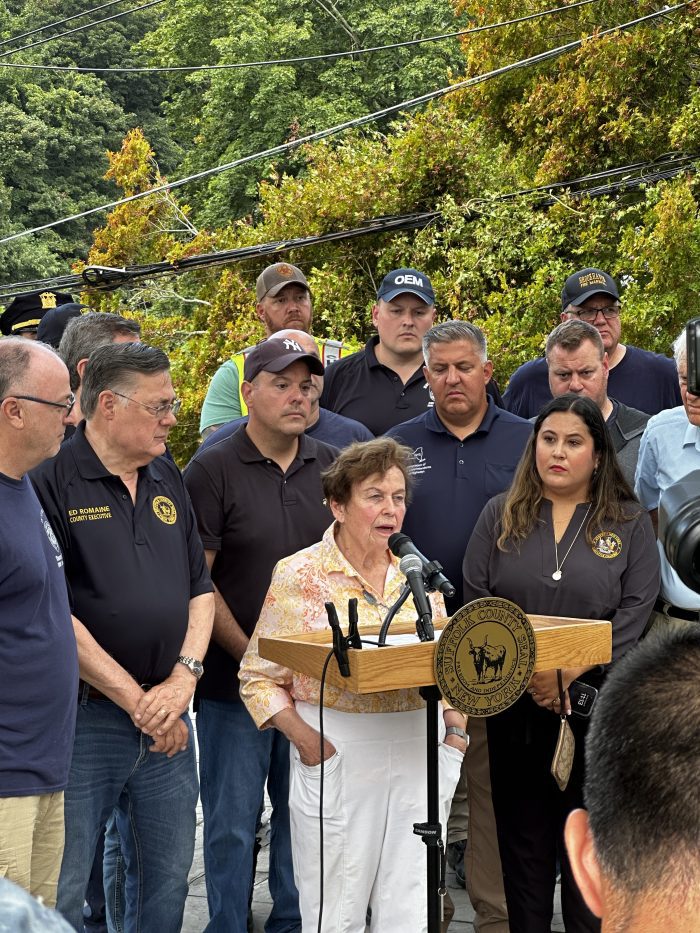By Toni-Elena Gallo with contributions by Lynn Hallarman and John Broven
Photo gallery to come.
According to the New York State Weather Risk Communication Center, Stony Brook recorded 9.4 inches of rain, in the 24 hours between Sunday, Aug. 18, and Monday, Aug. 19, amounting to a rainfall that is not just a once in a lifetime event —but a one-in-a-thousand year-event.
At a Monday press conference, County Executive Ed Romaine (R) spoke about the shock many Long Islanders experienced.
“This storm was not predicted for northern Suffolk,” he said. “This storm was over Connecticut and probably traveled south. When you get almost 10 inches of rain, that’s a once [in a lifetime event]. Unfortunately, these once-in-a-lifetime events seem to be coming more than that. I don’t think we’re going to have to wait another hundred years for another storm like this.”
“It tells you the impact that climate change is having on our weather,” the county executive added.
Stony Brook
In Stony Brook village, Harbor Road was split in half, and the pond at Avalon Nature Preserve ran off into nearby Stony Brook Harbor, taking dead fish and turtles with it.
“We have put drones up to document the before and after. We believe the damage will [amount to] $25 million, minimum. A minimum, between cleanup that’s required [not just here, but] other parts of the county, like Rocky Point,” Romaine said.
“We will document everything that we do, and all the expenditures that will be made, because we will be seeking some hope of state [and] federal reimbursement, because this is a huge hit on local government, on the town and on the villages along the North Shore,” he added.
At the press conference, Gloria Rocchio, president of The Ward Melville Heritage Organization, expressed her sadness and frustration, but was able to provide a small glint of hope.
“We did have a structural engineer come already, to check the [historic] Grist Mill … and it is, [fortunately] structurally sound. It was built in 1699. In 1750 the dam broke for the first time, and then once again in the 1800s, and the last time it broke was 1910,” she said.
Over at Stony Brook University, Judy Pittigher, an office administrator at the Renaissance School of Medicine, suffered an office full of water damage and a collapsed ceiling, forcing her to work from home for, at least, the remainder of the week.
“The squares of one doctor’s tile roof collapsed; the floor is disgusting, covered in mush. By the time I got there, half the rugs had already been pulled up … anything on them was destroyed, like boxes. One box had this past graduation’s programs, and someone picked it up and put it on my desk, and it was sopping wet,” she said.
Smithtown
In Smithtown, the Nissequogue River dam broke from the nearly 10 inches of rain. Two residents were saved by members of the Smithtown Fire Department, as they were trapped on the second floor of their home.
This is despite the town’s recent stormwater and drain infrastructure upgrades. However, Supervisor Ed Wehrheim (R) said that Smithtown was lucky, in comparison to the nearby villages, as a result of these proactive measures.
Rocky Point
Rocky Point was extensively impacted, as well.
“I tried to take a tour of most of the damage this morning … and several catchment basins overflowed,” Romaine said. “I went down Hagerman Landing Road, and the tops of all the cars in sight had mud. The mudslide that came down Hagerman Landing Road was, easily, 7 to 9 feet. It left its mark on the trees, and the houses, right up to the windows. We had to rescue someone down there from their rooftop.”
Port Jefferson
At about 3 a.m., Monday, a rush of stormwater cascaded down Main Street, past CVS, affecting local property and flooding the Port Jefferson fire station.
According to Fire Commissioner Thomas Meehan, the flooding rose to about 36 inches in the station, bringing sewage and other debris into the building.
“We were just recovering from the flooding we had three years ago,” he said.
Port Jefferson village officials assisted the fire station in the initial cleanup in the early hours of Monday morning.
Several businesses along the Main Street corridor were impacted, including Theatre Three [see editorial].
Huntington
According to a Town of Huntington press release, “The Highway Department took to the roads at the early onset of the storm. After surveying the town, they reported approximately 10 sink holes and minimal trees down. Flooding, however, was the predominant issue, with the town reporting heavy flooding in a few areas.”
All areas will be rebuilt
The Town of Brookhaven’s superintendent of highways, Dan Losquadro (R), explained how the topography of the North Shore created a disastrous alignment of storm conditions.
“Water picks up velocity, as it travels down into these natural drainage points,” he said. “Many of these areas were built a very long time ago. They just have catch basins, and do not have sumps recharge basins, as we call them. [Even so] recharge basins, optimally, can only store 8 inches of water, and a catch basin, no more than 2 to 3.”
“This exceeded even the capacity of a modern sump. So, we saw our systems completely overwhelmed by this volume of water in such a short period of time,” he elaborated.
As for what’s next, Losquadro said, “We will get into the engineering and estimating phase, throughout the day, and, probably, for days to come. We have, unfortunately, been through this process with FEMA, and the state before, even back to the recovery from [Hurricane] Sandy. We will do our best to secure funding, from the higher levels of government, to ease the burden on our local taxpayers because as the county executive and the supervisor [Dan Panico (R)] rightly pointed out, many of these projects are beyond our ability to fund on a local level.”
“This process will take a great deal of time,” Romaine said. “[This damage behind me] will require permitting, not only from D.C., but from the EPA, and from the Army Corps of Engineers as well.”
Both Losquadro and Romaine expressed that the parts of the county hit by this storm will be built back “stronger and better.”
“We will clean this up, whatever it takes. These are our communities, these are our friends, our neighbors. We’re one county, one people and we will work together,” Romaine said.
















